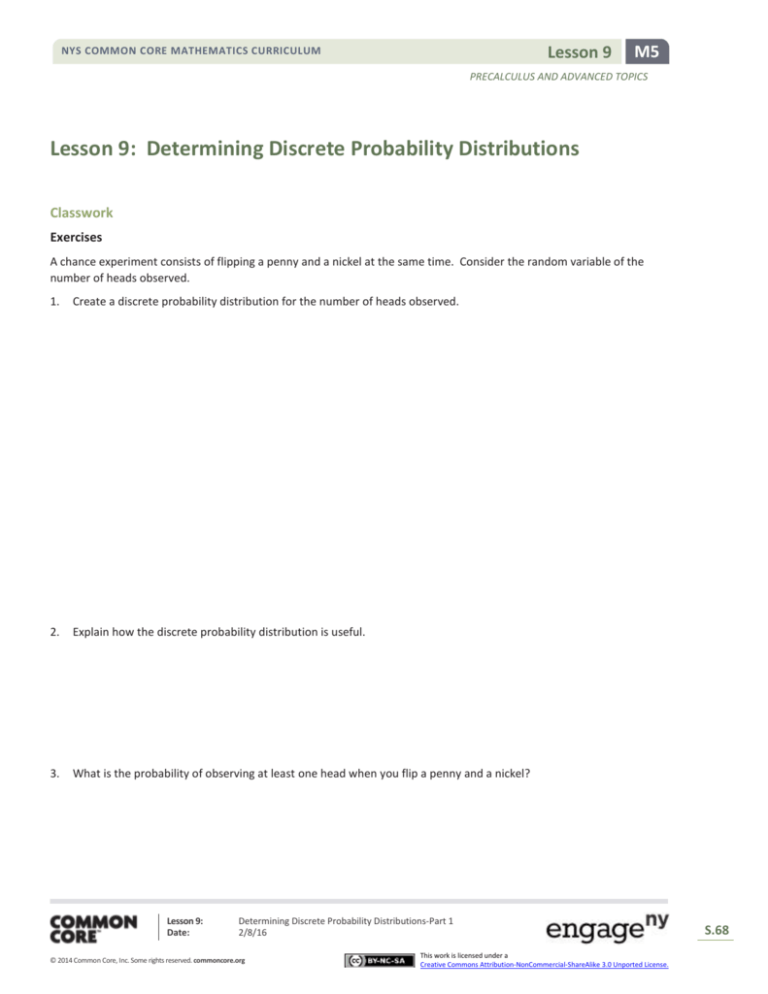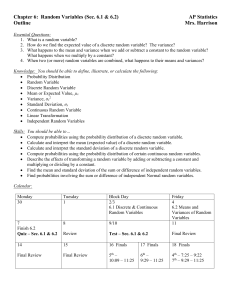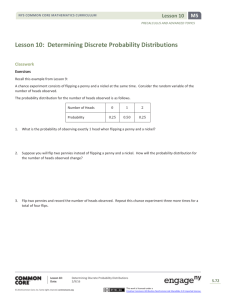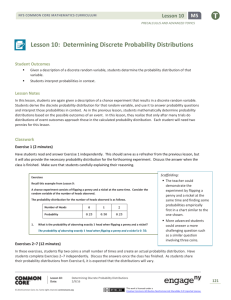
Lesson 9
NYS COMMON CORE MATHEMATICS CURRICULUM
M5
PRECALCULUS AND ADVANCED TOPICS
Lesson 9: Determining Discrete Probability Distributions
Classwork
Exercises
A chance experiment consists of flipping a penny and a nickel at the same time. Consider the random variable of the
number of heads observed.
1.
Create a discrete probability distribution for the number of heads observed.
2.
Explain how the discrete probability distribution is useful.
3.
What is the probability of observing at least one head when you flip a penny and a nickel?
Lesson 9:
Date:
Determining Discrete Probability Distributions-Part 1
2/8/16
© 2014 Common Core, Inc. Some rights reserved. commoncore.org
This work is licensed under a
Creative Commons Attribution-NonCommercial-ShareAlike 3.0 Unported License.
S.68
Lesson 9
NYS COMMON CORE MATHEMATICS CURRICULUM
M5
PRECALCULUS AND ADVANCED TOPICS
Suppose that on a particular island 60% of the eggs of a certain type of bird are female. You spot a nest of this bird and
find three eggs. You are interested in the number of male eggs. Assume the gender of each egg is independent of the
other eggs in the nest.
4.
Create a discrete probability distribution for the number of male eggs in the nest.
5.
What is the probability that no more than two eggs are male?
6.
Explain the similarities and differences between this probability distribution and the one in the first part of the
lesson.
Lesson 9:
Date:
Determining Discrete Probability Distributions-Part 1
2/8/16
© 2014 Common Core, Inc. Some rights reserved. commoncore.org
This work is licensed under a
Creative Commons Attribution-NonCommercial-ShareAlike 3.0 Unported License.
S.69
Lesson 9
NYS COMMON CORE MATHEMATICS CURRICULUM
M5
PRECALCULUS AND ADVANCED TOPICS
7.
The manufacturer of a certain type of tire claims that only 5% of the tires are defective. All four of your tires need
to be replaced. What is the probability you would be a satisfied customer if you purchased all four tires from this
manufacturer? Would you purchase from this manufacturer? Explain your answer using a probability distribution.
Lesson 9:
Date:
Determining Discrete Probability Distributions-Part 1
2/8/16
© 2014 Common Core, Inc. Some rights reserved. commoncore.org
This work is licensed under a
Creative Commons Attribution-NonCommercial-ShareAlike 3.0 Unported License.
S.70
Lesson 9
NYS COMMON CORE MATHEMATICS CURRICULUM
M5
PRECALCULUS AND ADVANCED TOPICS
Lesson Summary
To derive a probability distribution for a discrete random variable, you must consider all possible
outcomes of the chance experiment.
A discrete probability distribution displays all possible values of a random variable and the corresponding
probabilities.
Problem Set
1.
2.
3.
4.
5.
About 11% of adult Americans are left-handed. Suppose that two people are randomly selected from this
population.
a.
Create a discrete probability distribution for the number of left-handed people in a sample of two randomly
selected adult Americans.
b.
What is probability that at least one person in the sample is left-handed?
In a large batch of M&M candies, about 24% of the candies are blue. Suppose that three candies are randomly
selected from the large batch.
a.
Create a discrete probability distribution for the number of blue candies out of the three randomly selected
candies.
b.
What is probability that at most two candies are blue? Explain how you know.
In the 21st century, about 3% of mothers give birth to twins. Suppose three mothers-to-be are chosen at random.
a.
Create a discrete probability distribution for the number of sets of twins born from the sample.
b.
What is the probability that all three mothers do not give birth to twins?
About three in 500 people have type O-negative blood. Though it is one of the least frequently-occurring blood
types, it is one of the most sought-after because it can be donated to people who have any blood type.
a.
Create a discrete probability distribution for the number of people who have type O-negative blood in a
sample of two randomly selected adult Americans.
b.
Suppose two samples of two people are taken. What is the probability that at least one person in each sample
has type O-negative blood?
The probability of being struck by lightning in one’s lifetime is approximately 1 in 3,000.
a.
What is the probability of being struck by lightning twice in one’s lifetime?
b.
In a random sample of three adult Americans, how likely is it that at least one has been struck by lightning
exactly twice?
Lesson 9:
Date:
Determining Discrete Probability Distributions-Part 1
2/8/16
© 2014 Common Core, Inc. Some rights reserved. commoncore.org
This work is licensed under a
Creative Commons Attribution-NonCommercial-ShareAlike 3.0 Unported License.
S.71












